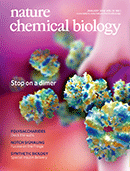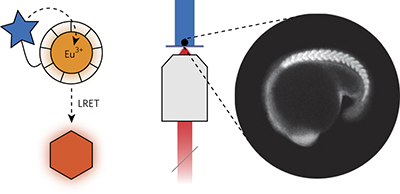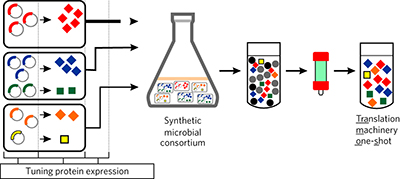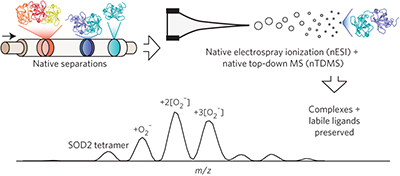TABLE OF CONTENTS
|
January 2018 Volume 14, Issue 1 |
 |  |  |
 |  Research Highlights Research Highlights
 News and Views News and Views
 Brief Communication Brief Communication
 Articles Articles
|  | Advertisement |  |  |  | Nature Research present this Collection of articles celebrating the 2017 Nobel Prize in Chemistry to Jacques Dubochet, Joachim Frank and Richard Henderson, recognised "for developing cryo-electron microscopy for the high-resolution structure determination of biomolecules in solution". Produced with support from | |
|
|
 |
|
 |
 |
Research Highlights |  Top Top |
 |
 |
 |
Microbiology: Trapping Rac1 | Resistance mechanisms: Watering down a warhead | RNA modifications: Ribosomes get decorated | Neurobiology: Defining your territory
|
News and Views |  Top Top |
 |
 |
 |
| |
 |
Brief Communication |  Top Top |
 |
 |
 |
|
 |
Articles |  Top Top |
 |
 |
 |
|
 |
 |
 |
Ultrasensitive optical imaging with lanthanide lumiphores pp15 - 21
Ukrae Cho, Daniel P Riordan, Paulina Ciepla, Kiranmai S Kocherlakota, James K Chen et al.
doi:10.1038/nchembio.2513

Ultrasensitive imaging of lanthanide chelates is achieved by integrating transreflected illumination, luminescence resonance energy transfer, and time-resolved microscopy.
|
|
|
 |
 |
 |
|
 |
 |
 |
Synthetic microbial consortia enable rapid assembly of pure translation machinery pp29 - 35
Fernando Villarreal, Luis E Contreras-Llano, Michael Chavez, Yunfeng Ding, Jinzhen Fan et al.
doi:10.1038/nchembio.2514

Strains of Escherichia coli, each expressing a subset of the 34 translation machinery proteins, are grown in synthetic microbial consortia to enable the efficient isolation of the full machinery from a single culturing, lysis, and purification procedure.
|
|
|
 |
 |
 |
Top-down characterization of endogenous protein complexes with native proteomics pp36 - 41
Owen S Skinner, Nicole A Haverland, Luca Fornelli, Rafael D Melani, Luis H F Do Vale et al.
doi:10.1038/nchembio.2515

A multistage tandem mass spectrometry approach enables the application of native proteomics to characterize intact endogenous protein complexes in discovery mode, including covalent modifications as well as noncovalently bound cofactors and ligands.
|
|
|
 |
 |
 |
|
 |
 |
 |
|
 |
 |
 |
|
 |
 |
 |
|
 |
 |
 |
|
 |
 |
 |
|
 |
 |
 |
Synthetic beta cells for fusion-mediated dynamic insulin secretion pp86 - 93
Zhaowei Chen, Jinqiang Wang, Wujin Sun, Edikan Archibong, Anna R Kahkoska et al.
doi:10.1038/nchembio.2511

Synthetic beta cells were fabricated through 'vesicles-in-vesicle' liposomal superstructures equipped with glucose-sensing and membrane-fusion machinery, thus enabling sensing of graded glucose levels and secretion of insulin via fusion processes.
|
|
|
 |
 |
 |
|
 |
 Top Top |
 |
 |
 |  |  |  |  |  | Natureevents is a fully searchable, multi-disciplinary database designed to maximise exposure for events organisers. The contents of the Natureevents Directory are now live. The digital version is available here.
Find the latest scientific conferences, courses, meetings and symposia on natureevents.com. For event advertising opportunities across the Nature Publishing Group portfolio please contact natureevents@nature.com |  |  |  |  |  |
|
 |


No comments:
Post a Comment